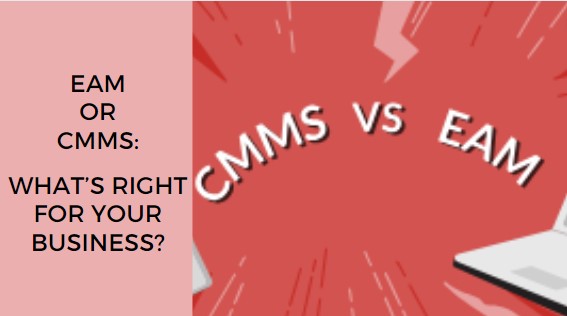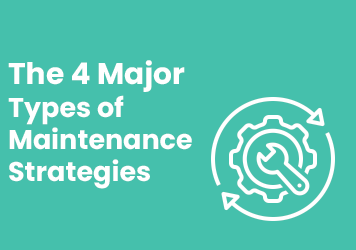
EAM or CMMS : What should you choose for your business?
Madhurima Sanyal |
10 Jan 2024 |
14:40 PM
- Defining CMMS and EAM
- CMMS: Functions and Benefits
- Exploring CMMS Capabilities
- Finding the Best CMMS Software Matching Maintenance Requirements
- Drive Proactive and Preventive Maintenance Strategies
- Streamlining Work Order Management
- Visibility for Inventory Management
- CMMS and EAM: Key Differences and Similarities
- CMMS vs. EAM: Understanding the Crucial Differences
- Comparing CMMS vs. EAM Software solution
- Exploring Similarities Between EAM and CMMS software
- Choosing the Right Solution
- Conclusion

The 4 Major Types of Maintenance Strategies
Madhurima Sanyal 24 Jun 2024 | 11:54 AMLearn about the four major types of maintenance strategies: reactive, preventive, predictive, and reliability-centered maintenance. Understand their benefits, implementation, and how to choose the right strategy for your organization....
Understanding the Need: Does Your Business Need a CMMS or an EAM?
When it comes to managing your business assets and maintenance operations efficiently, choosing between Enterprise Asset Management (EAM) and Computerized Maintenance Management System (CMMS) becomes crucial. But how do you determine which system aligns better with your organizational goals and operational needs?
In today's competitive business landscape, optimizing asset performance and streamlining operations are key priorities. EAM and CMMS solutions offer distinct approaches to address these challenges. EAM primarily focuses on the holistic management of an organization's assets throughout their entire lifecycle, while CMMS revolves around maintenance management, ensuring the smooth functioning of equipment and facilities.
It's essential to assess your business requirements accurately. Are you primarily looking to streamline maintenance tasks, minimize downtime, and ensure compliance with asset management standards? Or do you seek a comprehensive system that encompasses broader aspects such as financial management, asset lifecycle optimization, and strategic planning?
Defining CMMS and EAM
Let's break down the fundamental definitions: A CMMS is designed to streamline maintenance activities, such as work order management, preventive maintenance scheduling, and inventory tracking. On the other hand, an EAM system takes a more comprehensive approach, integrating asset lifecycle management, maintenance operations, and financial aspects, providing a more holistic view of your organization's assets.
Understanding the nuances between these systems is essential. While CMMS is tailored for operational tasks and operational efficiency, Enterprise Asset Management system offers a broader spectrum, aligning assets with strategic business objectives. Both systems play vital roles, but the decision ultimately depends on your business's specific needs and long-term objectives.
As we delve deeper into the intricacies of CMMS and EAM software, we'll explore their functionalities, differences, and the criteria that can guide you towards making an informed decision for your business's future.
CMMS: Functions and Benefits
In the landscape of modern business operations, understanding the functions and benefits of Computerized Maintenance Management System (CMMS) is pivotal for efficient asset and maintenance management. Let's explore how CMMS solutions empower businesses to streamline their operations effectively.
Exploring CMMS Capabilities
CMMS solutions are designed to revolutionize maintenance operation by providing a centralized platform for managing various tasks. These systems offer a range of capabilities, including work order management, asset tracking, and maintenance scheduling. By employing CMMS, businesses gain the ability to optimize maintenance processes, track equipment performance, and ensure timely repairs.
Finding the Best CMMS Software Matching Maintenance Requirements
Selecting the right CMMS software aligned with your maintenance requirements is crucial. Factors such as scalability, ease of use, integration capabilities, and compliance standards play a significant role. Evaluate software options that match your business's specific needs, considering features like preventive maintenance, inventory management, and reporting functionalities.
Drive Proactive and Preventive Maintenance Strategies
One of the key advantages of a robust CMMS system lies in its ability to facilitate proactive and preventive maintenance strategies. By scheduling routine inspections, tracking asset health, and identifying potential issues in advance, businesses can prevent unexpected downtimes, reduce repair costs, and prolong asset lifespan.
Streamlining Work Order Management
Efficient work order management is a cornerstone of successful maintenance operations. CMMS enables the creation, assignment, and tracking of work orders seamlessly. It ensures that maintenance tasks are prioritized, assigned to the right personnel, and completed within stipulated timelines, thereby optimizing operational efficiency.
Visibility for Inventory Management
CMMS solutions offer enhanced visibility into inventory management by tracking spare parts, materials, and supplies necessary for maintenance activities. This visibility ensures adequate stock levels, minimizes overstocking or shortages, and streamlines the procurement process, contributing to smoother operational workflows.
CMMS systems, with their diverse functionalities and capabilities, are instrumental in driving operational efficiency and maximizing asset performance, making them an invaluable asset for businesses across various industries.
CMMS and EAM: Key Differences and Similarities
When evaluating between Enterprise Asset Management (EAM) system and Computerized Maintenance Management Systems (CMMS) for your business, comprehending the critical differences and uncovering the potential similarities is pivotal. Let's delve into the comparative analysis to aid in your decision-making process.
CMMS vs. EAM: Understanding the Crucial Differences
The fundamental differences lie in their scope and functionality. CMMS primarily focuses on maintenance-related tasks, such as work order management, equipment tracking, and maintenance scheduling.
In contrast, EAM software encompasses a more comprehensive approach, integrating broader asset management aspects like lifecycle optimization, financial management, and strategic planning. Understanding these distinctions is crucial to aligning the system with your business objectives effectively.
Comparing CMMS vs. EAM Software solution
A comparative analysis between CMMS and EAM systems enables a deeper understanding of their respective strengths and weaknesses. While CMMS excels in streamlining operations and ensuring equipment uptime, EAM offers a holistic view of physical assets, fostering long-term planning, compliance adherence, and overall business optimization. Evaluating the specific functionalities vis-à-vis your business needs will guide you towards the optimal choice.
Exploring Similarities Between EAM and CMMS software
Despite their differing focuses, EAM systems and CMMS share some commonalities. Both systems aim to enhance operational efficiency, reduce downtime, and prolong asset lifespan. They utilize preventive maintenance strategies, provide insights into asset performance, and facilitate data-driven decision-making processes. Acknowledging these similarities can highlight the core functionalities that align with your business's maintenance and asset management goals.
Deciding between CMMS and EAM software necessitates a comprehensive evaluation of your organization's priorities, operational requirements, and long-term objectives. Understanding their differences and identifying shared functionalities will steer you towards selecting the most suitable system for your business.
Choosing the Right Solution
Which Solution Fits Your Business Needs?
Selecting between EAM systems and CMMS necessitates a meticulous evaluation of your business requirements. If your focus primarily revolves around streamlining day-to-day maintenance tasks, overseeing work orders, and optimizing equipment uptime, a CMMS might align more closely with your needs.
On the other hand, if your objectives extend to encompassing a comprehensive view throughout the entire asset life cycle, strategic planning, and compliance adherence, an EAM software solution may be the more suitable choice.
While CMMS systems emphasizes efficient maintenance systems, EAM systems offers a broader spectrum, integrating financial aspects, asset lifecycle management, and strategic planning. Understanding your organization's operational priorities and long-term goals is instrumental in making an informed decision.
Conclusion
In the complex landscape of choosing between Enterprise Asset Management (EAM) and Computerized Maintenance Management Systems (CMMS) for your business, the decision-making process hinges on several pivotal factors. Understanding the significance of selecting the right solution for your business operations can significantly impact your organization's efficiency and long-term success.
Making Informed Choices: The Importance of EAM or CMMS for Your Business
The decision to adopt either EAM or CMMS profoundly impacts various facets of your business. Selecting the appropriate system aligns your operational processes with your overarching business objectives, ensuring streamlined maintenance, optimal asset management, and enhanced operational efficiency.
By opting for the most suitable system, businesses can expect:
-
Streamlined Operations: Effortlessly manage operational tasks, work orders, and equipment tracking for seamless day-to-day operations.
-
Optimized Asset Lifecycle: Gain insights into asset performance, ensuring longevity and efficient utilization throughout the lifecycle.
-
Strategic Planning: Engage in forward-thinking strategies, including compliance adherence, financial management, and long-term planning.
The integration of an efficient maintenance and asset management system not only enhances productivity but also fosters adaptability, scalability, and competitiveness in a dynamic market landscape.
As you contemplate the choice between EAM and CMMS, consider your business's unique needs, operational requirements, scalability, and long-term goals. Engaging with system providers, understanding their capabilities, and aligning them with your business objectives will facilitate a well-informed decision.
By leveraging the capabilities of EAM or CMMS, businesses can fortify their operations, drive sustainable growth, and position themselves as industry leaders.